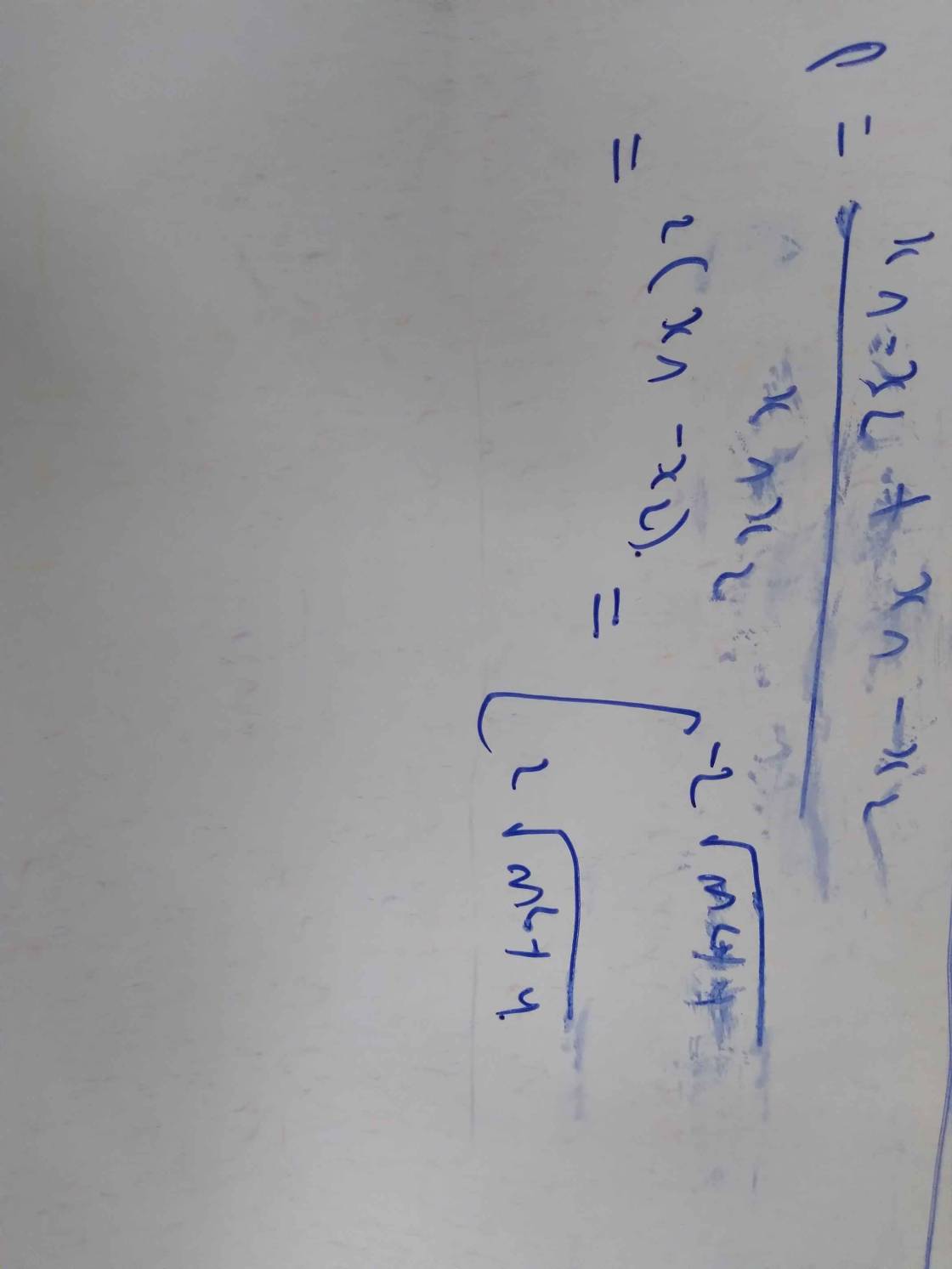
Hãy nhập câu hỏi của bạn vào đây, nếu là tài khoản VIP, bạn sẽ được ưu tiên trả lời.


Δ=(-m)^2-4(2m-4)
=m^2-8m+16=(m-4)^2>=0
=>Phương trình luôn có hai nghiệm
a: x1^2+x2^2=13
=>(x1+x2)^2-2x1x2=13
=>m^2-2(2m-4)-13=0
=>m^2-4m-5=0
=>m=5 hoặc m=-1
b: x1^3+x2^3=9
=>(x1+x2)^3-3*x1x2(x1+x2)=9
=>m^3-3*(2m-4)*m=9
=>m^3-6m^2+12m-9=0
=>m=3

\(x^2-\left(m-1\right)x-2=0\)
a=1; b=-m+1; c=-2
Vì a*c=-2<0
nên phương trình luôn có hai nghiệm phân biệt
Theo Vi-et, ta có:
\(\left\{{}\begin{matrix}x_1+x_2=\dfrac{-b}{a}=\dfrac{-\left[-\left(m-1\right)\right]}{1}=m-1\\x_1\cdot x_2=\dfrac{c}{a}=\dfrac{-2}{1}=-2\end{matrix}\right.\)
\(\left(x_1-x_2\right)^2=\left(x_1+x_2\right)^2-4x_1x_2\)
\(=\left(m-1\right)^2-4\cdot\left(-2\right)=\left(m-1\right)^2+8\)
=>\(x_1-x_2=\pm\sqrt{\left(m-1\right)^2+8}\)
\(\dfrac{x_1}{x_2}=\dfrac{x_2^2-3}{x_1^2-3}\)
=>\(x_1\left(x_1^2-3\right)=x_2\left(x_2^2-3\right)\)
=>\(x_1^3-x_2^3=3x_1-3x_2\)
=>\(\left(x_1-x_2\right)\left(x_1^2+x_2^2+x_1x_2-3\right)=0\)
=>\(\left(x_1-x_2\right)\left[\left(x_1+x_2\right)^2-x_1x_2-3\right]=0\)
=>\(\left[{}\begin{matrix}x_1-x_2=0\\\left(m-1\right)^2-\left(-2\right)-3=0\end{matrix}\right.\)
=>\(\left[{}\begin{matrix}\sqrt{\left(m-1\right)^2+8}=0\left(vôlý\right)\\\left(m-1\right)^2-1=0\end{matrix}\right.\)
=>\(\left(m-1\right)^2=1\)
=>\(\left[{}\begin{matrix}m-1=1\\m-1=-1\end{matrix}\right.\Leftrightarrow\left[{}\begin{matrix}m=2\\m=0\end{matrix}\right.\)

\(\Delta=1-4m\ge0\Rightarrow m\le\dfrac{1}{4}\)
Theo hệ thức Viet: \(\left\{{}\begin{matrix}x_1+x_2=-1\\x_1x_2=m\end{matrix}\right.\)
\(x_1^2+x_2^2=3\Leftrightarrow\left(x_1+x_2\right)^2-2x_1x_2=3\)
\(\Leftrightarrow\left(-1\right)^2-2m=3\)
\(\Leftrightarrow-2m=2\)
\(\Rightarrow m=-1\) (thỏa mãn)

a) Khi m = 0 thì phương trình trở thành:
\(x^2+2\left(0-2\right)x-0^2=0\)
\(\Leftrightarrow x^2+2\cdot-2x-0=0\)
\(\Leftrightarrow x^2-4x=0\)
\(\Leftrightarrow x\left(x-4\right)=0\)
\(\Leftrightarrow\left[{}\begin{matrix}x=0\\x=4\end{matrix}\right.\)
b) Ta có:
\(\left|x_1\right|-\left|x_2\right|=6\)
\(\Leftrightarrow x^2_1+x_2^2-2\left|x_1x_2\right|=36\)
\(\Leftrightarrow\left(x_1+x_2\right)^2-2x_1x_2-2\left|x_1x_2\right|=36\)
Mà: \(x_1+x_2=-2\left(m-2\right)=4-2m\)
\(x_1x_2=-m^2\)
\(\Leftrightarrow\left(4-2m\right)^2-2\cdot-m^2-2\cdot m^2=36\)
\(\Leftrightarrow16-16m+4m^2+2m^2-2m^2=36\)
\(\Leftrightarrow\left(4-2m\right)^2=6^2\)
\(\Leftrightarrow\left[{}\begin{matrix}4-2m=6\\4-2m=-6\end{matrix}\right.\)
\(\Leftrightarrow\left[{}\begin{matrix}2m=-2\\2m=10\end{matrix}\right.\)
\(\Leftrightarrow\left[{}\begin{matrix}m=-1\\m=5\end{matrix}\right.\)

\(\text{Δ}=\left[-2\left(m-2\right)\right]^2-4\cdot1\cdot\left(3m-3\right)\)
\(=\left(2m-4\right)^2-4\left(3m-3\right)\)
\(=4m^2-16m+16-12m+12\)
\(=4m^2-28m+28\)
Để phương trình có hai nghiệm thì Δ>=0
=>\(4m^2-28m+28>=0\)
\(\Leftrightarrow4m^2-2\cdot2m\cdot7+49-21>=0\)
=>\(\left(2m-7\right)^2>=21\)
=>\(\left[{}\begin{matrix}2m-7>=\sqrt{21}\\2m-7< =-\sqrt{21}\end{matrix}\right.\Leftrightarrow\left[{}\begin{matrix}m>=\dfrac{7+\sqrt{21}}{2}\\m< =\dfrac{7-\sqrt{21}}{2}\end{matrix}\right.\)
\(\left|x_1\right|-\left|x_2\right|=6\)
=>\(\left(\left|x_1\right|-\left|x_2\right|\right)^2=36\)
=>\(x_1^2+x_2^2-2\left|x_1x_2\right|=36\)
=>\(\left(x_1+x_2\right)^2-2x_1x_2-2\left|x_1x_2\right|=36\)
=>\(\left(-2m+4\right)^2-2\left(3m-3\right)-2\left|3m-3\right|=36\)
=>\(4m^2-16m+16-6m+6-6\left|m-1\right|=36\)
=>\(4m^2-22m+22-36=6\left|m-1\right|\)
=>\(6\left|m-1\right|=4m^2-22m-14\)(1)
TH1: m>=1
(1) tương đương với \(4m^2-22m-14=6\left(m-1\right)\)
=>\(4m^2-22m-14-6m+6=0\)
=>\(4m^2-28m-8=0\)
=>\(m^2-7m-2=0\)
=>\(\left[{}\begin{matrix}m=\dfrac{7+\sqrt{57}}{2}\left(nhận\right)\\m=\dfrac{7-\sqrt{57}}{2}\left(loại\right)\end{matrix}\right.\)
TH2: m<1
(1) tương đương với: \(4m^2-22m-14=6\left(1-m\right)\)
=>\(4m^2-22m-14=6-6m\)
=>\(4m^2-16m-20=0\)
=>m^2-4m-5=0
=>(m-5)(m+1)=0
=>\(\left[{}\begin{matrix}m-5=0\\m+1=0\end{matrix}\right.\Leftrightarrow\left[{}\begin{matrix}m=5\left(loại\right)\\m=-1\left(nhận\right)\end{matrix}\right.\)


\(x^2-mx-3=0\)
\(\Delta=m^2+12>0\)nên phương trình luôn có hai nghiệm phân biệt \(x_1,x_2\).
Theo định lí Viete ta có:
\(\hept{\begin{cases}x_1+x_2=m\\x_1x_2=-3\end{cases}}\).
\(\left(x_1+6\right)\left(x_2+6\right)==2019\)
\(\Leftrightarrow x_1x_2+6\left(x_1+x_2\right)+36=2019\)
\(\Rightarrow-3+6m+36=2019\)
\(\Leftrightarrow m=331\)..